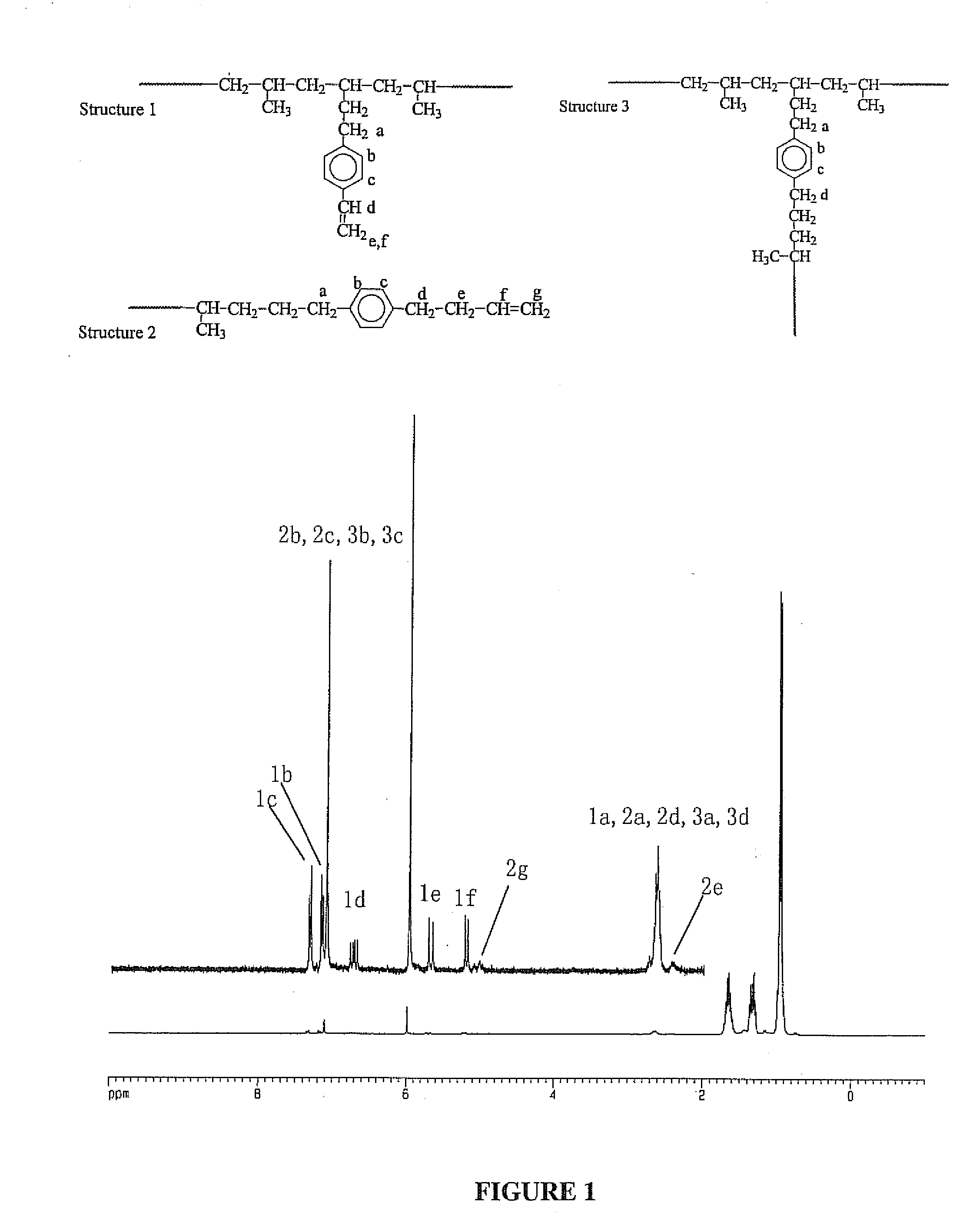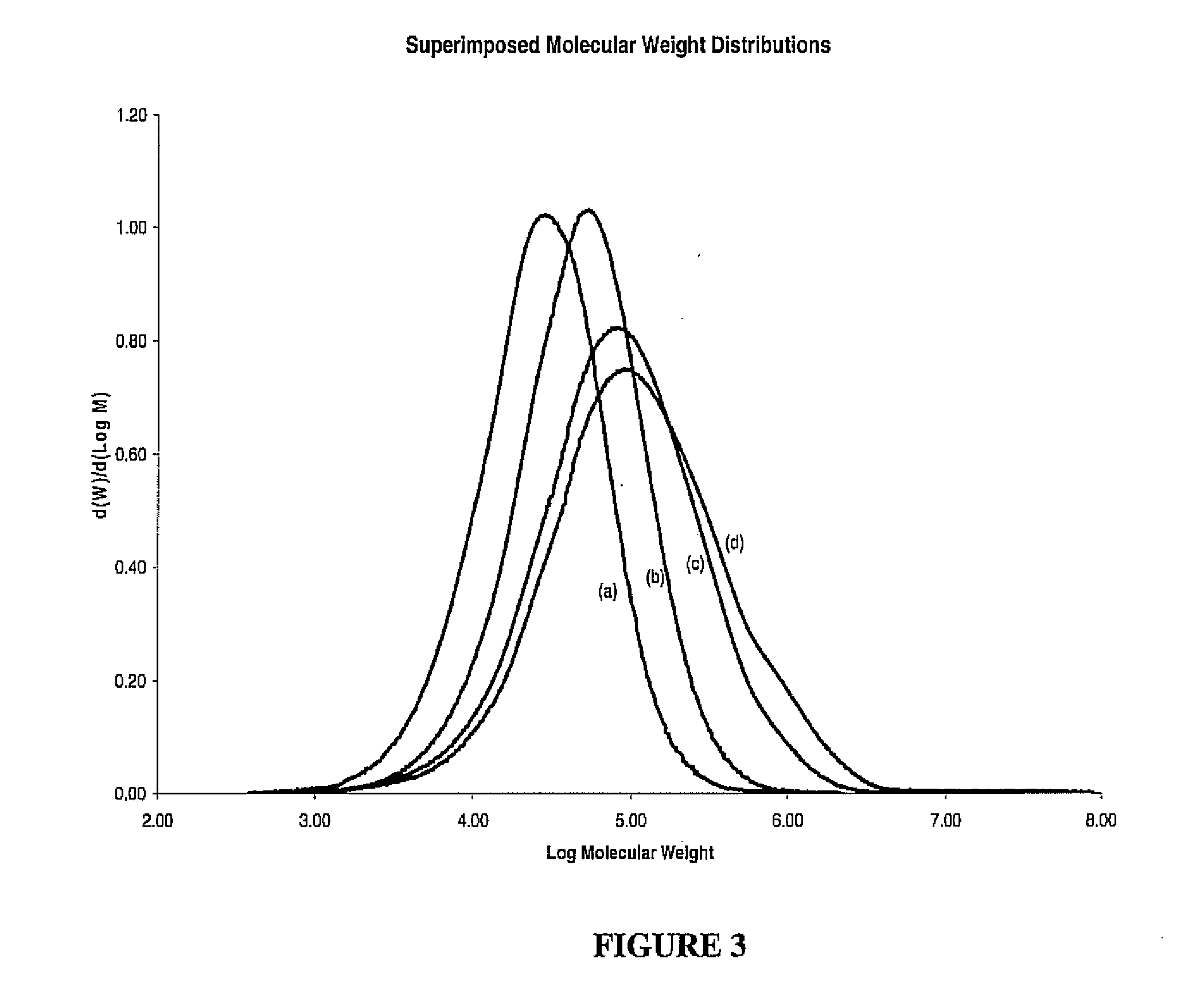One-pot process and reagents for preparing long chain branched polymers
a polymer and one-pot technology, applied in the field of long chain branching polymers, can solve the problems of low melt strength, undesirable mechanical properties, and poor processibility
- Summary
- Abstract
- Description
- Claims
- Application Information
AI Technical Summary
Benefits of technology
Problems solved by technology
Method used
Image
Examples
example 1
[0080]LCB polymers are synthesized according to inventive processes, then weighed and analyzed by a combination of analytic methods, including nuclear magnetic resonance (NMR), differential scanning calorimetry (DSC) and gel permeation chromatography with three detectors (GPC-triple detectors), including reflection index, light scattering, and intrinsic viscosity, to determine the monomer conversion, polymer composition, thermal transition temperature, molecular weight, and LCB molecular structure as described in more detail below. For comparison, some control linear polymers are also prepared and examined, they are prepared under the same reaction conditions except using two modified single-function “T” reagents that contain either X or Y functionality to prepare the corresponding main chain and side chain, respectively, of LCB polyolefin.
[0081]These two control reactions, using butenylbenzene (V′) and p-butylstyrene (VI′) to replace p-(3-butenyl)styrene / hydrogen “T” reagent (IV), ...
example 2
Control Reaction 1—Copolymerization of Propylene and Butenylbenzene using a rac-Me2Si[2-Me-4-Ph(Ind)]2ZrCl2 / MAO Catalyst
[0083]A control reaction is conducted to examine the copolymerization activity between propylene and butenylbenzene (V′) using rac-Me2Si[2-Me-4-Ph(Ind)]2ZrCl2 / MAO catalyst system to form linear propylene / butenylbenzene copolymer (VII′). In a dry box, 50 ml of toluene and 1.5 ml of MAO (30 wt % in toluene) are charged into a parr 450 ml stainless autoclave equipped with a mechanical stirrer. After removal from the box, the reactor is injected with 1 ml of butenylbenzene before charging 100 psi propylene to saturate the toluene solution at ambient temperature. About 1.25×10−6 mole of rac-Me2Si[2-Me-4-Ph(Ind)]2ZrCl2 in toluene solution is then syringed into the reactor to start the copolymerization reaction. After 3 minutes, this batch slurry polymerization is terminated by adding 100 ml of dilute HCl solution in methanol. The resulting PP copolymer (VII′) is further ...
example 3
Control Reaction 2—Chain Transfer Reaction in rac-Me2Si[2-Me-4-Ph(Ind)]2ZrCl2 / MAO Mediated Propylene Polymerization using a p-Butylstyrene (VI′) / H2 Chain Transfer Agent
[0084]In a dry box, 50 ml of toluene and 1.5 ml of MAO (30 wt % in toluene) are charged into a parr 450 ml stainless autoclave equipped with a mechanical stirrer. After removal from the box, the reactor is purged with hydrogen (20 psi) before injecting 0.5 ml of p-butylstyrene. The reactor is then charged with 100 psi propylene to saturate the toluene solution at ambient temperature and to increase the total pressure in the reactor to 120 psi. About 1.25×10−6 mole of rac-Me2Si[2-Me-4-Ph(Ind)]2ZrCl2 in toluene solution is then syringed into the reactor, under rapid stirring, to initiate the polymerization. Additional propylene is fed continuously into the reactor to maintain a constant pressure (120 psi) during the entire course of the polymerization. After a 15 minute reaction at 30° C., the polymer solution is quench...
PUM
| Property | Measurement | Unit |
|---|---|---|
| Melting point | aaaaa | aaaaa |
| Temperature | aaaaa | aaaaa |
| Temperature | aaaaa | aaaaa |
Abstract
Description
Claims
Application Information
 Login to View More
Login to View More - R&D
- Intellectual Property
- Life Sciences
- Materials
- Tech Scout
- Unparalleled Data Quality
- Higher Quality Content
- 60% Fewer Hallucinations
Browse by: Latest US Patents, China's latest patents, Technical Efficacy Thesaurus, Application Domain, Technology Topic, Popular Technical Reports.
© 2025 PatSnap. All rights reserved.Legal|Privacy policy|Modern Slavery Act Transparency Statement|Sitemap|About US| Contact US: help@patsnap.com



